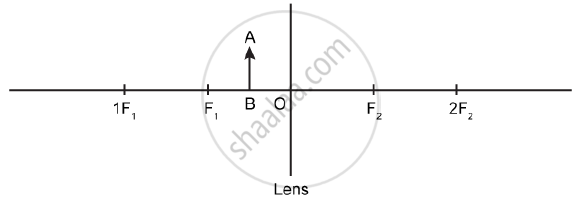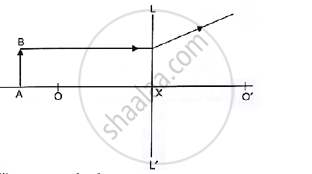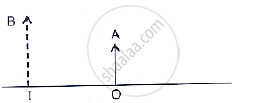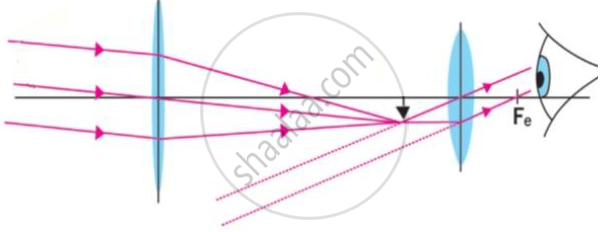Advertisements
Advertisements
प्रश्न
Distinguish between:
Concave lens and Convex lens
उत्तर
| Concave lens | Convex lens | |
| 1. | It is a diverging lens because it diverges the rays falling on it. | It is a converging lens because it converges the rays falling on it. |
| 2. | It is thin at the center and bulged at the edge. | It is thin at the edge and bulged at the centre. |
| 3. | The image formed by concave lens is always diminished and virtual. | The image formed by convex lens can be real as well as virtual. Also, the image formed can be diminished as well as magnified. |
| 4. | It has a virtual focus. | It has a real focus. |
संबंधित प्रश्न
An object of height 2.5 cm is placed at a distance of 15 cm from the optical centre 'O' of a convex lens of focal length 10 cm. Draw a ray diagram to find the position and size of the image formed. Mark optical 'O', principal focus F and height of the image on the diagram.
Where should an object be placed so that a real and inverted image of the same size as the object is obtained using a convex lens?
An object AB is placed between O and F1 on the principal axis of a converging lens as shown in the diagram.

Copy the diagram and by using three standard rays starting from point A, obtain an image of the object AB.
Complete the following table:
| Instrument | Number of Convex Lenses |
Use |
| Simple Microscope | .............. | .............. |
| Compound Microscope | .............. | .............. |
| Telescope | .............. | .............. |
Draw a labelled ray diagram to show how a ray of light passes through a parallel sided glass block:
if it hits the glass block at 90° (that is, perpendicular to the glass block)
State any two uses of convex lenses.
Fill in the following blank with suitable word:
The image in a convex lens depends upon the distance of the ........... from the lens.
Distinguish between a convex lens and concave lens. Which of the two is a converging lens : convex lens of concave lens?
Explain with the help of a diagram, why the convex lens is also called a converging lens.
A burning candle whose flame is 1.5 cm tall is placed at a certain distance in front of a convex lens. An image of candle flame is received on a white screen kept behind the lens. The image of flame also measures 1.5 cm. If f is the focal length of convex lens, the candle is placed:
(a) at f
(b) between f and 2f
(c) at 2f
(d) beyond 2f
Find the nature, position and magnification of the images formed by a convex lens of focal length 0.20 m if the object is placed at a distance of:
0.25 m
A student did an experiment with a convex lens. He put an object at different distances 25 cm, 30 cm, 40 cm, 60 cm and 120 cm from the lens. In each case he measured the distance of the image from the lens. His results were 100 cm, 24 cm, 60 cm, 30 cm and 40 cm, respectively. Unfortunately his results are written in wrong order.
Rewrite the image distances in the correct order.
What kind of lens can form:
an erect magnified image?
What kind of lens can form:
am erect diminished image?
The focal lengths of four convex lenses P, Q, R and S are 20 cm, 15 cm, 5 cm and 10 cm, respectively. The lens having greatest power is :
(a) P
(b) Q
(c) R
(d) S
The diagrams (a) and (b) in Figure below show the refraction of a monochromatic ray of light through a parallel sided glass block and a prism respectively. In each diagram, label the incident, refracted emergent rays and the angle of deviation.

Show by a diagram the refraction of two light rays incident parallel to the principal axis on a convex lens by treating it as a combination of a glass slab and two triangular glass prisms.
Study the diagram below.

what are the points O, O’ called?
The given below figure shows an object OA and its image IB formed by a lens. State three characteristics of the image.

A convex lens forms an image of an object equal to the size of the object. Draw a diagram to illustrate it.
A lens forms an inverted image of an object. Name the kind of lens.
While determining the focal length of a convex lens, you try to focus the image of a distant object formed by the lens on the screen. The image formed on the screen, as compared to the object, should be
(A) erect and highly diminished
(B) erect and enlarged
(C) inverted and enlarged
(D) inverted and highly diminished
List four properties of the image formed by a convex mirror.
Observe the following figure and answer the questions.

a) Which optical instrument shows arrangement of lenses as shown in the figure?
b) Write in brief the working of this optical instrument.
c) How can we get different magnifications in this optical instrument?
d) Draw the figure again and labelled it properly
State two applications of a convex lens.
If an object is placed in front of a convex lens beyond 2F1, then what will be the position, relative size, and nature of an image which is formed? Explain with a ray diagram.
Point out the difference between a convex lens and a concave lens.
What happens to the image formed by a convex lens if its lower part is blackened?
A concave mirror and convex lens are held in water. What changes, if any, do you expect in their focal length?
Can a normal convex lens behave like a concave lens and vice-versa?
Draw a diagram to show the convergent action of a convex lens by treating it as a combination of glass block and two triangular glass prisms, with the aid of two parallel incident rays.
Where should an object be placed in front of a convex lens so as to form an inverted and enlarged image? Will the image be real or virtual? Draw a ray diagram to illustrate your answer.

A candle is placed between f and 2f a convex lens. Draw a ray diagram showing the position of the image.
An object is placed in front of a convex lens such that the image formed has the same size as that of the object. Draw a ray diagram to illustrate this.
For a specific glass lens f = 0.5 m. This is the only information given to the student. Which type of lens is given to him and what is its power?
A convex lens of focal length 20 cm can produce a magnified virtual as well as real image. Is this a correct statement? If yes, where shall the object be placed in each case for obtaining these images?
Distinguish between:
Concave lens and Convex Lens
